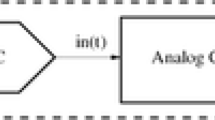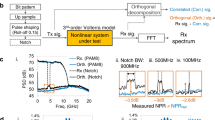Abstract
The effect of test environment noise (tester noise) on test waveforms is considered. We show that tests generated ignoring the tester noise characteristics are prone to failure when actually applied to the circuit-under-test (CUT). The failure may result in the good circuit being declared faulty or the faulty circuit being declared good. This failure is independent of the fault model and nature of the test, i.e., AC or DC, time domain or frequency domain. We characterize the total noise at the primary outputs (PO's) of the circuit using second order statistics. We use the noise power spectrum and root mean square (RMS) values to make decisions about the test waveforms and recommend more noise-robust tests. For non-linear circuits we use the Central Limit Theorem of statistics to approximate narrow band noise at a primary input (PI) by a sum of sinusoidal distributions, and we use Monte-Carlo simulations to determine the noise at the PO's in the time domain. Results of experiments on an instrumentation amplifier, a biquadratic filter, and a Gilbert multiplier are presented, which prove that valid tests in a noise-free environment are invalid when tester noise is considered.
Similar content being viewed by others
References
P.R. Gray and R.G. Meyer, Analysis and Design of Analog Integrated Circuits, John Wiley & Sons, Inc., 1995, chap. 11, pp. 715–784.
K. Joardar, “A Simple Approach to Modeling Cross-Talk in Integrated Circuits,” IEEE J. of Solid-State Circuits, Vol. 29, No. 10, pp. 1212–1219, Oct. 1994.
D.K. Su, M.J. Loinaz, S. Masui, and B.A. Wooley, “Experimental Results and Modeling Techniques for Substrate Noise in Mixed-Signal Integrated Circuits,” IEEE J. of Solid-State Circuits, Vol. 28, No. 4, pp. 420–430, April 1993.
R. Rohrer, L. Nagel, R. Meyer, and L. Weber, “Computationally Efficient Electronic-Circuit Noise Calculations,” IEEE J. of Solid-State Circuits, Vol. SC-6, No. 4, pp. 204–213, Aug. 1971.
T.W. Anderson, An Introduction to Multivariate Statistical Analysis. John Wiley & Sons, Inc., New York, 2nd edition, 1984.
R. Duda and P. Hart, Pattern Classification and Scene Analysis, Wiley, 1973, chap. 3, pp. 44–80.
P. Bolcato and R. Poujois, “A New Approach for Noise Simulation in Transient Analysis,” Proc. of the IEEE Int. Symp. on Circuits and Systems, May 1992, pp. 887–890.
A. Meixner and W. Maly, “Fault Modeling for the Testing of Mixed Integrated Circuits,” Proc. of the IEEE Int. Test Conf., Oct. 1991, pp. 564–572.
G. Devarayanadurg and M. Soma, “Analytical Fault Modeling and Static Test Generation for Analog ICs,” Proc. of the Int. Conf. on Computer Aided Design, Nov. 1994, pp. 44–47.
N.B. Hamida and B. Kaminska, “Multiple Fault Analog Circuit Testing by Sensitivity Analysis,” J. of Electronic Testing–Theory and App., Vol. 4, No. 2, pp. 331–343, Nov. 1993.
N. Nagi, A. Chatterjee, and J.A. Abraham, “DRAFTS: Discretized Analog Circuit Fault Simulator,” Proc. of the ACM/IEEE Design Automation Conf., June 1993, pp. 509–514.
R. Ramadoss and M.L. Bushnell, “Test Generation for Mixed-Signal Devices using Signal Flow Graphs,” Proc. of the Ninth Int. Conf. on VLSI Design, Jan. 1996, pp. 242–248.
M. Okumura, H. Tanimoto, T. Itakura, and T. Sugawara, Numerical Noise Analysis for Nonlinear Circuits with a Periodic Large Signal Excitation Including Cyclostationary Noise Sources, IEEE Trans. on Circuits and Systems, Vol. 40, No. 9, pp. 581–590, Sep. 1993.
A. Demir, “Time-Domain Non-Monte Carlo Noise Simulation for Nonlinear Dynamic Circuits with Arbitrary Excitations,” M.S. Project EECS Dept. UCB/ERL M94/39, U. California at Berkeley, May 1994.
K. Helmreich and G. Reinwardt, “Virtual Test of Noise and Jitter Parameters,” Proc. of the Int. Test Conf., Oct. 1996, pp. 461–470.
I.L. Wemple and A.T. Yang, “Mixed-Signal Switching Noise Analysis Using Voronoi-Tessellated Substrate Macromodels,” Proc. of the ACM/IEEE Design Automation Conf., June 1995, pp. 439–444.
W.R. Bennett, “Methods of Solving Noise Problems,” Proceedings of the Institute of Radio Engineers, Vol. 44, No. 2, May 1956, pp. 609–638.
C.A. Desoer and E.S. Kuh, Basic Circuit Theory, McGraw-Hill, New York, 1969, chap. 4, pp. 200–230.
G. Roberts, “Mixed-Signal Testing,” Tutorial at the Int. Test Conf., Washington, DC, USA, 1996.
A.L. Rosenblum and M.S. Ghausi, “Multiparameter Sensitivity in Active RC Networks,” IEEE Trans. on Circuit Theory, Vol. CT-18, No. 6, pp. 592–599, Nov. 1971.
Author information
Authors and Affiliations
Rights and permissions
About this article
Cite this article
Iyer, M.K., Bushnell, M. Effect of Noise on Analog Circuit Testing. Journal of Electronic Testing 15, 11–22 (1999). https://doi.org/10.1023/A:1008343108840
Issue Date:
DOI: https://doi.org/10.1023/A:1008343108840




